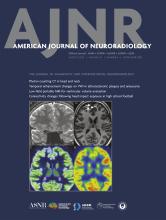This article requires a subscription to view the full text. If you have a subscription you may use the login form below to view the article. Access to this article can also be purchased.
Abstract
BACKGROUND AND PURPOSE: MS lesions exhibit varying degrees of axonal and myelin damage. A comprehensive description of lesion phenotypes could contribute to an improved radiologic evaluation of smoldering inflammation and remyelination processes. This study aimed to identify in vivo distinct MS lesion types using quantitative susceptibility mapping and susceptibility mapping–weighted imaging and to characterize them through T1-relaxometry, myelin mapping, and diffusion MR imaging. The spatial distribution of lesion phenotypes in relation to ventricular CSF was investigated.
MATERIALS AND METHODS: MS lesions of 53 individuals were categorized into iso- or hypointense lesions, hyperintense lesions, and paramagnetic rim lesions, on the basis of their appearance on quantitative susceptibility mapping alone, according to published criteria, and with the additional support of susceptibility mapping–weighted imaging. Susceptibility values, T1-relaxation times, myelin and free water fractions, intracellular volume fraction, and the orientation dispersion index were compared among lesion phenotypes. The distance of the geometric center of each lesion from the ventricular CSF was calculated.
RESULTS: Eight hundred ninety-six MS lesions underwent the categorization process using quantitative susceptibility mapping and susceptibility mapping–weighted imaging. The novel use of susceptibility mapping–weighted images, which revealed additional microvasculature details, led us to re-allocate several lesions to different categories, resulting in a 35.6% decrease in the number of paramagnetic rim lesions, a 22.5% decrease in hyperintense lesions, and a 17.2% increase in iso- or hypointense lesions, with respect to the categorization based on quantitative susceptibility mapping only. The outcome of the categorization based on the joint use of quantitative susceptibility mapping and susceptibility mapping–weighted imaging was that 44.4% of lesions were iso- or hypointense lesions, 47.9% were hyperintense lesions, and 7.7% were paramagnetic rim lesions. A worsening gradient was observed from iso- or hypointense lesions to hyperintense lesions to paramagnetic rim lesions in T1-relaxation times, myelin water fraction, free water fraction, and intracellular volume fraction. Paramagnetic rim lesions were located closer to ventricular CSF than iso- or hypointense lesions. The volume of hyperintense lesions was associated with a more severe disease course.
CONCLUSIONS: Quantitative susceptibility mapping and susceptibility mapping–weighted imaging allow in vivo classification of MS lesions into different phenotypes, characterized by different levels of axonal and myelin loss and spatial distribution. Hyperintense lesions and paramagnetic rim lesions, which have the most severe microstructural damage, were more often observed in the periventricular WM and were associated with a more severe disease course.
ABBREVIATIONS:
- ARMSS
- Age-Related MS Severity Score
- EDSS
- Expanded Disability Status Scale
- FWF
- free water fraction
- HC
- healthy control
- HYPER
- hyperintense lesions
- ISO-HYPO
- iso- or hypointense lesions
- ICVF
- intracellular volume fraction
- MWF
- myelin water fraction
- ODI
- orientation dispersion index
- PRL
- paramagnetic rim lesion
- QSM
- quantitative susceptibility mapping
- SMWI
- susceptibility mapping–weighted imaging
- © 2024 by American Journal of Neuroradiology












